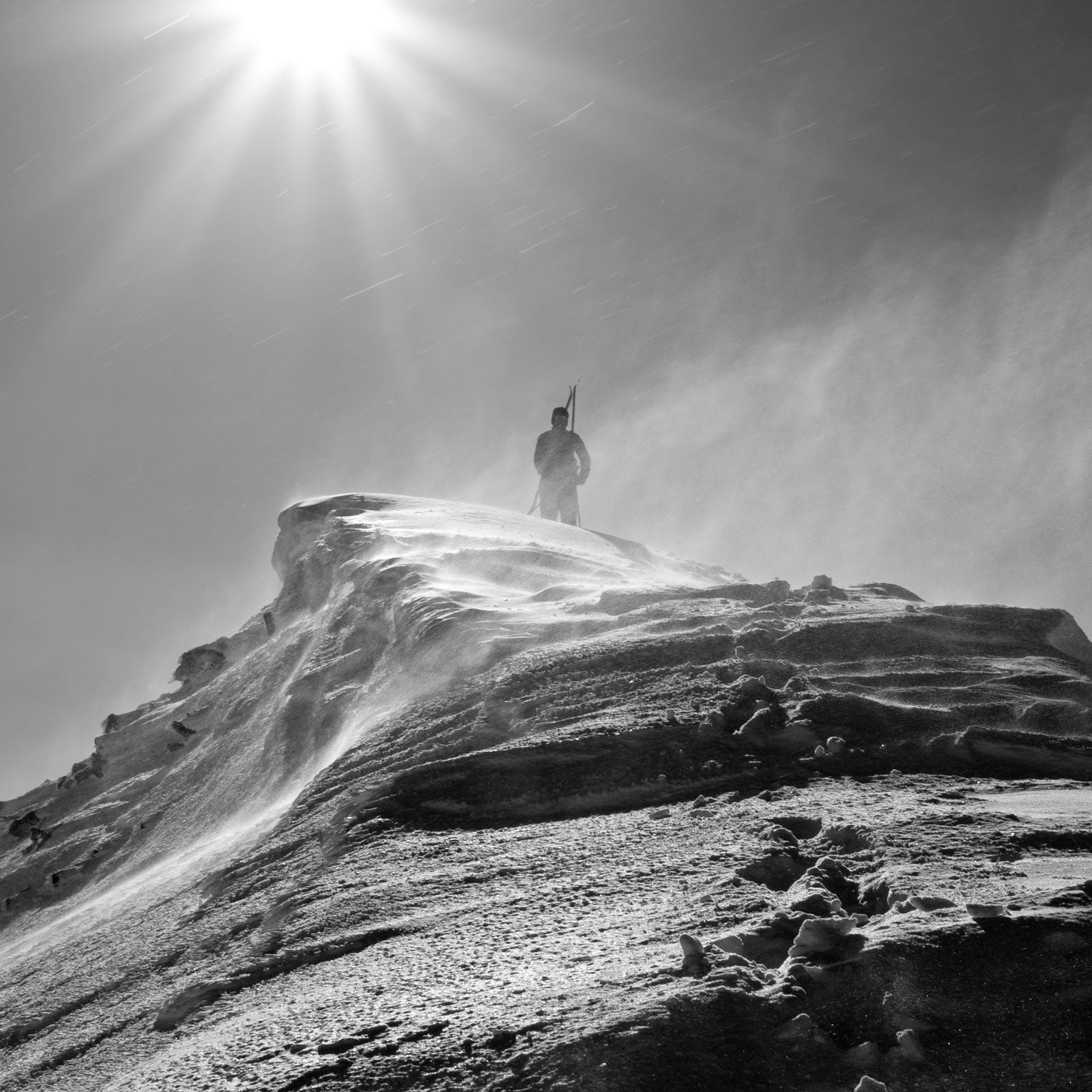Three, two, one, dropping—but wait, there’s something he’s got to do first.
Before extreme skier Julian Carr launches off any of the monster cliffs that have made him famous, he does three things. Always three. Never four. Two is out of the question. He exhales deeply, looks up at the sky, and clicks his poles together, just once.
Professional skier and wingsuit BASE jumper JT Holmes also clicks his poles together before launching off cliffs, but not once. “Twice,” he says.
What Holmes does not do is look toward the sky. Instead, a little while before pole-clicking, he eats a green apple. “In the beginning,” he says, “it was for energy and hydration. The tartness was like a shot of caffeine. But this has changed over time. The apple is one piece of the equation as I build my courage to do something gnarly.”
Former professional kayaker Jamie Simon has a different approach. “Before I run any big waterfall,” she explains, “I take a few deep breaths and visualize all the bones in my body. It gets me out of my soft tissue and into my core, and it grounds me.”
Sports rituals—those quirky behaviors carried out by athletes in the hope of influencing performance—are a mainstay of our A-game. Most athletes have a few, but not many will talk about them. This raises a variety of questions. Where do our preperformance routines come from? Are they superstitious nonsense, or do they help our cause? More specifically: If Carr pole-clicks twice instead of once, or if Holmes substitutes a red apple for a green one, will the gods of cliff-hucking take notice?
Skier Matt Reardon used to wear the same merino long johns before trying anything of consequence. If things were going well, he eschewed washing them, which led to an abundance of funky smells by season’s end.
Scientists have been trying to answer these questions for over half a century, and they haven’t had an easy time of it. Part of the problem lies in defining what they’re studying. Consider the multiple game-day habits of tennis player Rafael Nadal. These include: always taking a pre-court cold shower, toweling down after every point, picking at his underwear and shirt and slicking the sweat from his nose before every serve, crossing the lines on the court with his right foot first, and, in front of his chair between games, meticulously arranging his two beverages of choice—one a sports drink, the other plain water—in a line so straight that global positioning systems might be involved. Which of these are rituals and which routines? And what’s the difference, anyway?
Hard to say, isn’t it?
Researchers have firmer definitions. Preperformance routines, to use the preferred term, should have performance benefits. They calm anxiety and tighten focus. Traditionally, superstitious rituals are repetitive symbolic actions that lack a direct instrumental purpose—like how skier Matt Reardon used to always wear the same merino long johns before trying anything of consequence. (If things were going well, he eschewed washing them, which he admits led to an abundance of funky smells by season’s end.) But if wearing those long johns actually lowered Reardon’s anxiety (because he hadn’t violated his superstition), or if the pole-clicking displays of Carr and Holmes tighten their focus, then isn’t that a direct instrumental purpose?
Consider former Red Sox third baseman Wade Boggs’s famed fetishes: waking up at the same time every day, eating chicken and fielding 117 ground balls (no more, no less) before every game, always taking batting practice at 5:17 p.m., always running sprints at 7:17 p.m., then—and it’s worth pointing out that Boggs isn’t Jewish—scratching the Hebrew word chai (meaning “life”) into the dirt before each at bat. On the surface, much of Boggs’s behavior appears, to use the technical term, batshit crazy. But a regular sleep schedule is fantastic high-performance kung fu, and eating the same meal every day standardized Boggs’s energy levels and guaranteed he wouldn’t bonk in the eighth. And while the number 117 seems arbitrary, doing anything that many times will definitely warm up both the body and the mind.
To understand ritualized behavior, start with the fact that the brain is a meaning-making machine continually trying to link cause and effect. This is evolution at work. On a hunt, it helps to remember that the last time you went out, when the bushes started shaking, there was a rabbit inside. And if you happened to pound your spear on the ground twice, perhaps to improve your grip, before you discovered that rabbit, your brain may try to connect those dots.
That’s how superstitions are born.

And it may not just be humans who are wired this way. Famed psychologist B. F. Skinner discovered that pigeons also have this tendency. When Skinner placed extremely hungry birds in a cage with an automated feeding arm set to arrive at regular intervals, whatever a bird happened to be doing right before the food came—spinning in circles, pecking the air in the upper right corner of the cage—would later be repeated in an attempt to produce the same result. Skinner called this “superstitious behavior,” writing: “The bird behaves as if there was a causal relationship between its behavior and the presentation of food.”
It’s also worth noting that the birds’ state of hunger and stress may have created a feeling of uncertainty in them. This matters. Back in the early 1900s, anthropologist Bronislaw Malinowski was living among South Sea islanders and noticed that when they fished the dangerous waters beyond the reef, the men performed a series of rituals to ensure a safe and productive voyage. By contrast, when they fished the predictable waters of the local lagoon, they treated it like any other part of their day—no rituals required. From this, Malinowski concluded that when outcomes are important and situations uncertain, ritual behavior increases. It’s how we try to gain a little control over the uncontrollable.
The majority of batters and pitchers had a ritual of some sort, maybe not as extreme as Boggs’s winner-winner-chicken-dinner, but definitely distinctive.
The same is true in sports. In the 1970s, University of San Francisco anthropologist decided to investigate Malinowski’s theory in baseball. A former minor leaguer, he reasoned that while hitting and pitching are subject to random influences, fielding is a much steadier craft. Great players get a hit 30 percent of the time. Fielders snag balls at a much higher rate and with far less fanfare. Gmelch figured that if Malinowski was right, he’d find a greater number of idiosyncratic behaviors among pitchers and batters than among fielders. And that’s exactly what happened.
The majority of batters and pitchers had a ritual of some sort, maybe not as extreme as Boggs’s winner-winner-chicken-dinner, but definitely distinctive. Among fielders only one did, and he was in the middle of a fielding slump and couldn’t catch the flu. “Rituals are about confidence,” Gmelch explains. “It’s about gaining a feeling of control in the face of uncertainty. And the greater our sense of uncertainty—the more we want to feel in control—the more likely superstitious rituals are to develop.”
The most important discovery researchers have made about rituals is that they tend to work. Part of this, as Gmelch pointed out, is that we perform better when we feel a sense of control. But we also increase our focus and optimism about our chances for success. And don’t sleep on the placebo effect: superstitious rituals win games just as sure as sugar pills cure disease.
Also, context matters. Perform a random series of behaviors before a hard task under serious pressure and, likely as not, nothing happens. But give those behaviors a name, call them a ritual, and performance improves. The same works in the other direction, which helps explain taboos. No baseball player with any common sense dares mention a no-hitter before the final pitch is thrown, just as no action-sports athlete in his right mind says, “This is my last run.”
“You can’t even think it,” explains skate legend Danny Way. “The last time I made that mistake, I launched 20 feet out of the quarterpipe, drifted backward midair, smashed into the ramp, and shattered my ankle into pieces.”
Not everyone thinks preperformance rituals are the way to go. “I’m not bullish on them,” says sport psychologist Michael Gervais, who coached Red Bull athlete Felix Baumgartner through his jump from a helium balloon 128,100 feet above the earth and now works with the Seattle Seahawks. “Routines, be they preperformance or superstition, put form and structure around what’s formless and structureless. True masters of craft don’t need them. They know that sport is about adjusting to a spontaneous unfolding—their mastery comes from embracing uncertainty.”
The skin is the body’s largest organ, with the greatest number of sensory inputs. That’s why so many rituals have a tactile component.
But if you include flow states in this discussion, ritual and routine start to make even more sense. Defined as an optimal state of consciousness during which we feel and perform our best, flow refers to those in-the-zone moments of rapt attention when we get so focused on the task at hand that everything else melts away. Scientists have known about flow’s relationship to peak performance for a century, but recent research into the phenomenon can help us decode rituals, too.
Flow states have triggers, preconditions that drive us into the experience. While there are more than 20 known triggers, they all share one commonality—they significantly amp up attention. That is, flow shows up only when our focus is all in, right here, right now. That’s what these triggers do: they drive attention into the present moment.
One good example is “clear goals,” a trigger identified by the godfather of flow psychology, Mihaly Csikszentmihalyi. Clear goals keep us in the now, focused on what we’re doing and what we’re about to do. When goals are clear, attention can stay locked and loaded. This explains Boggs and his 117 grounders. Keeping the number in mind lowers cognitive load and keeps attention on the task at hand. Both drive flow—which helps win ballgames.
Another trigger is “deep embodiment,” first identified by the Flow Genome Project, a peak-performance research and training organization I cofounded in 2011. In our work with action-sport and adventure athletes, we’ve found that attention is heightened when multiple sensory streams are engaged—when we’re paying attention not just to sight and sound, but also to touch. The skin is the body’s largest organ, with the greatest number of sensory inputs. That’s why so many rituals have a tactile component—Boggs scratching chai into the dirt, Nadal plucking at his clothes—and it also explains the ski-pole click. The number of clicks doesn’t matter, but the engagement of multiple sensory streams sure does. In other words, thanks to our biology, the voodoo works.
Steven Kotler () is the author of .


